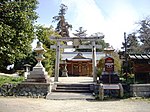Yamatonoaya clan (
| Yamatonoaya | |
|---|---|
 Omiashi-jinja of the Yamatonoaya clan | |
| Home province | Baekje or Gaya |
| Titles | Various |
| Founder | Achi no omi |
| Cadet branches |
|
Origins
editAccording to ancient Japanese records, Nihon Shoki and Kojiki, Yamatonoaya clan was one of the many clans that arrived from the Korean kingdoms during the reign of Emperor Ōjin.[1][2]
It is said that the clan started off small but gradually grew as other clans integrated themselves to the clan, later becoming one of the most influential clans in Japan.[1]
According to Teiji Kadowaki (
It is also said that "Hinokuma no Sato (
Etymology
editModern Japanese historians theorized that Yamatonoaya clan and its founder Achi no omi, originated from the Gaya confederacy, specifically from the kingdom of "Aya (
Relations with the Aya clan and other immigrant clans
editJapanese scholars have indicated that Yamatonoaya clan and other "Aya (
"Kawachinoaya (
Yamatonoaya clan also had a related clan called the "Sakanoue clan (
After the formation of the clans, the next immigrants were mainly called "Imaki no Ayahito (
Achievements
editIt is written both in Nihon Shoki and Kojiki that the clan specialized in architecture and carpentry.[14][15]
There were also heavily militarized, often guarding and protecting high-ranking members of the Soga clan[16] who also had deep connections with the Korean peninsula, specifically the kingdom of Baekje.[17]
Legacy
editOn top of being one of the most influential immigrant clans in Japan, clans related to Yamatonoaya became much more prominent after its fall.
The clan was divided into clans with distinct surnames, such as the aforementioned Sakanoue clan, the "Fumi clan (
See also
editReferences
edit- ^ a b c
森 浩一 ,門脇 禎二 (1997).渡来 人 :尾張 ・美濃 と渡来 文化 .春日井 シンポジウム (in Japanese).大 巧 社 . ISBN 4924899232. JPNO 99011294. - ^ 『
古代 国家 と天皇 』創 元 社 、1957年 - ^ a b c Takaoka, Nobuyuki;
片岡 ,伸行 (2023-07-31). "神 々のルーツ明日香 の地 と「今木 神 」 –全日本 民医連 ". www.min-iren.gr.jp (in Japanese). Japan Federation of Democratic Medical Institutions (全日本 民主 医療 機関 連合 会 ). - ^
高橋 1986, pp. 3–4. - ^ a b Suzuki, Takeju (1975).
偽 られた大王 の系譜 [Falsehoods of the great ruler] (in Japanese). the University of Michigan. p. 94. - ^ Ishiwatari, Shin'ichirō (1988).
日本 古代 王朝 の成立 と百済 [The formation of ancient Japanese clans and Kudara] (in Japanese). アジア史 研究 会 . p. 162. - ^ a b Suwa, Haruo (1993).
倭 族 と古代 日本 [Yamato people and ancient Japan] (in Japanese). p. 144. ISBN 9784639011910. - ^ a b Takemitsu, Makoto (2013).
真 説 日本 古代 史 [Truth behind ancient Japan] (in Japanese). PHP研究所 . p. 123. ISBN 9784569810751. - ^
安 羅 国 から移住 してきた東 漢 氏 は百済 の技術 をもっていた。
Yamatonoaya clan, being immigrants from the kingdom of Aya, brought with them the technologies of Baekje.— Makoto Takemitsu - ^
東 漢 氏 は百済 =安 羅 系 の、朝鮮半島 からの来住 者 たちなのである。
The Yamatonoaya clan was "Baekje and/or Aya" descent who had immigrated from the Korean Peninsula.— Takeju Suzuki - ^
「
安 羅 日本 府 」と改称 し、さらに『書 紀 』が「任 那 日本 府 」と改 めたのであります。
The name "Mimana of Japan" was in fact "Aya of Japan" before it was rewritten in the Nihon Shoki.— Haruo Suwa - ^ Janhunen, Juha (2010). "RECONSTRUCTING THE LANGUAGE MAP OF PREHISTORICAL NORTHEAST ASIA". Studia Orientalia 108 (2010).
... there are strong indications that the neighbouring Baekje state (in the southwest) was predominantly Japonic-speaking until it was linguistically Koreanized.
- ^ Vovin, Alexander (2013). "From Koguryo to Tamna: Slowly riding to the South with speakers of Proto-Korean". Korean Linguistics. 15 (2): 222–240.
- ^ "Nihon Shoki", Encyclopedic Dictionary of Archaeology, Cham: Springer International Publishing, pp. 935–936, 2021, doi:10.1007/978-3-030-58292-0_140217, ISBN 978-3-030-58291-3
- ^ Yasumaro Ō (2014). The Kojiki : an account of ancient matters. Translated by Gustav Heldt. New York: Columbia University Press. ISBN 978-0-231-53812-1. OCLC 899002167.
- ^
上田 1965, pp. 76–77. - ^ History of Nara